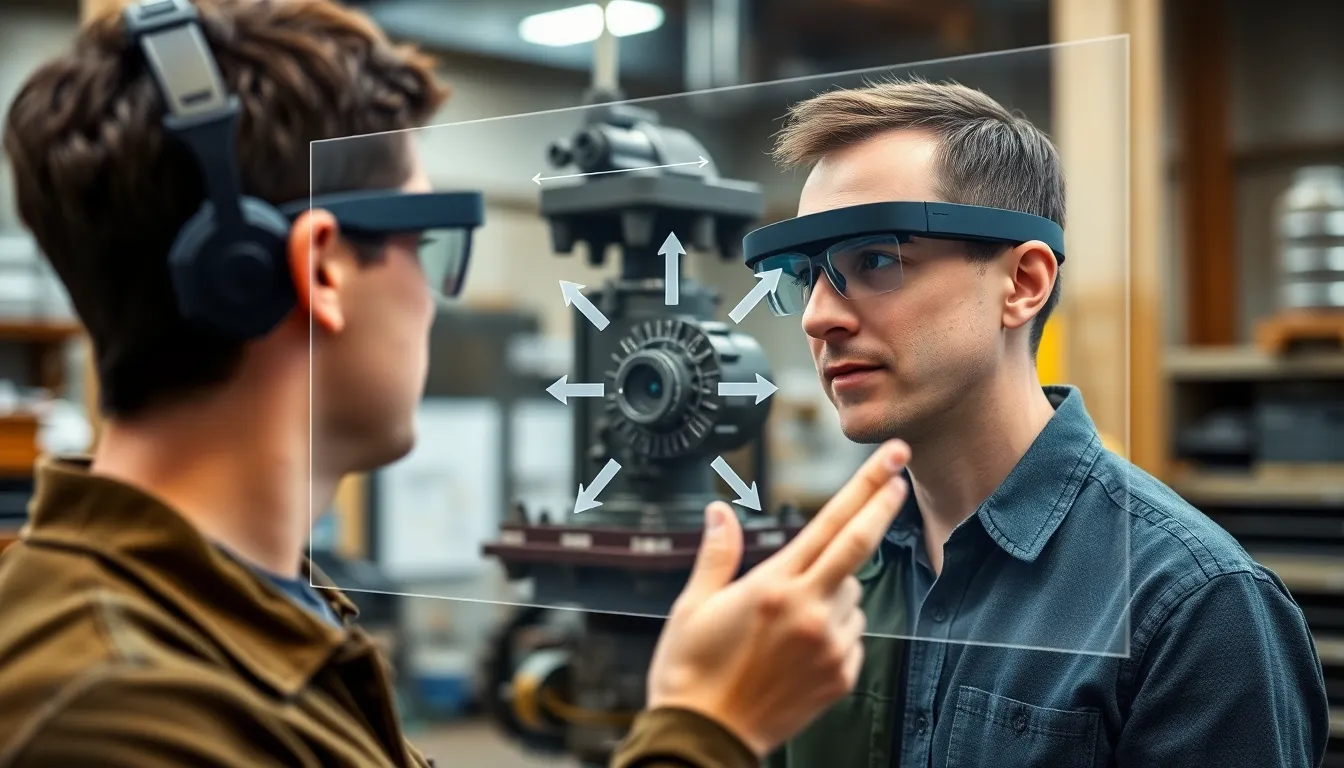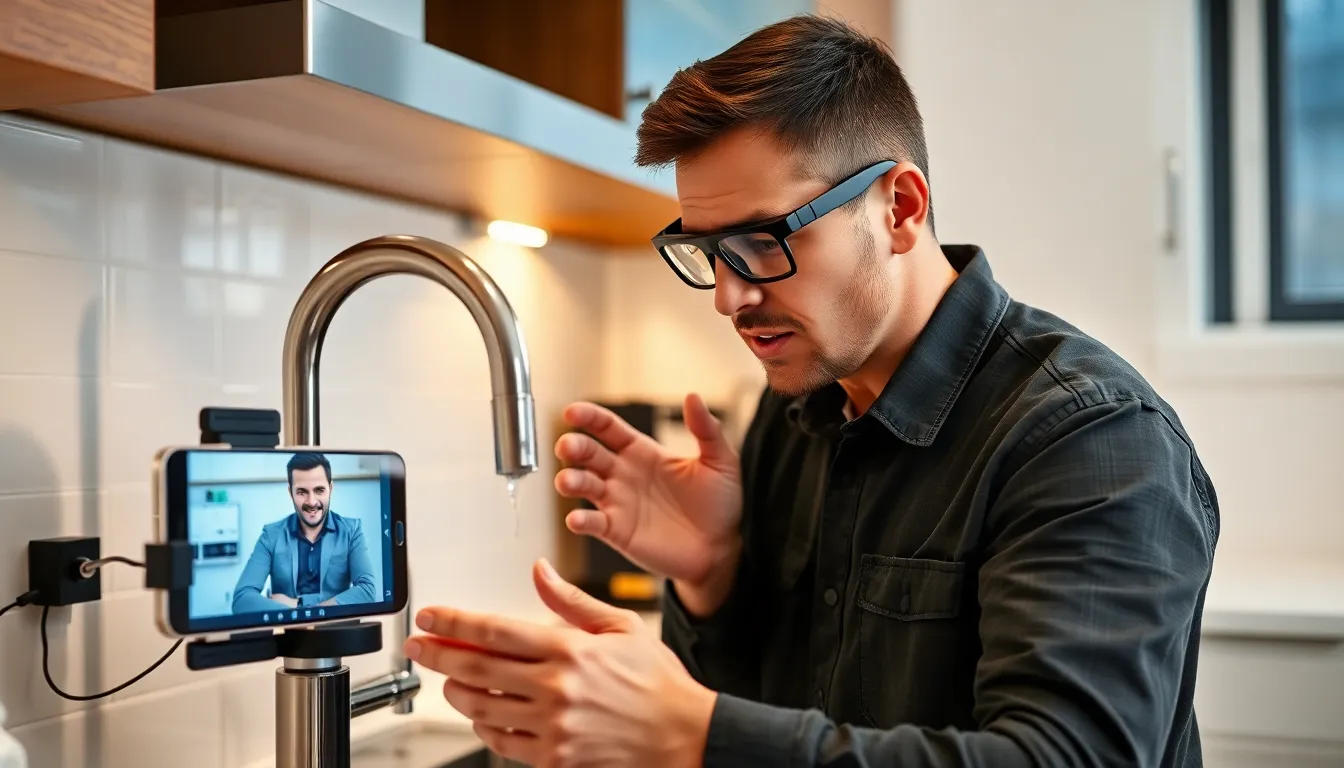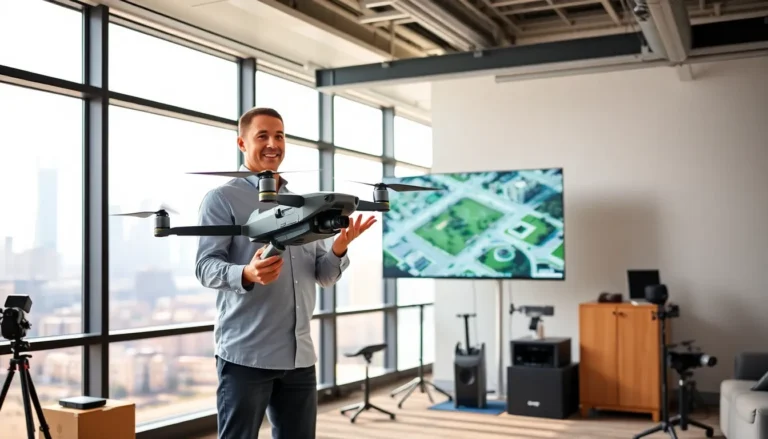Imagine trying to fix a leaky faucet while your expert friend is miles away, sipping coffee and enjoying their weekend. Enter augmented reality remote assistance, the superhero of tech that swoops in to save the day. With a sprinkle of digital magic, it bridges the gap between distance and expertise, allowing real-time guidance right before your eyes.
Table of Contents
ToggleOverview of Augmented Reality Remote Assistance
Augmented reality remote assistance leverages digital technology to enhance real-time interactions between users and experts. This approach uses smartphone cameras or smart glasses, enabling users to share live video feeds from their locations. Experts observe and guide users through complex tasks directly, regardless of geographical barriers.
Efficient communication is central to this technology. Users benefit from visual cues and annotations overlaid on their screens, providing clear instructions. Visual aids significantly reduce confusion, allowing users to follow directions step by step.
Industries such as manufacturing and healthcare increasingly adopt augmented reality remote assistance. Technicians can troubleshoot equipment issues remotely, minimizing downtime. Healthcare professionals guide patients through procedures, improving safety and understanding.
Data from studies show augmented reality can reduce problem resolution time by up to 30%. These efficiencies translate into cost savings and improved service quality for organizations. The user experience often leads to higher satisfaction rates as users feel supported and empowered.
Several platforms are available that specialize in augmented reality remote assistance. Popular options include Microsoft Dynamics 365 Remote Assist and Vuforia Chalk, each offering various features tailored for different industries. Companies can select tools that best fit their specific operational needs.
As its adoption grows, augmented reality remote assistance continues evolving. Innovations in technology promise richer interactions with enhanced functionality. This trend indicates a shift in how businesses operate, favoring smarter, more connected solutions for support and training.
Key Technologies Behind Augmented Reality Remote Assistance

Augmented reality remote assistance relies on several key technologies that enhance user experience and efficiency. These technologies include computer vision and wearable devices, which play critical roles in its functionality.
Computer Vision
Computer vision enables devices to interpret and understand visual information from the environment. This technology allows for real-time object recognition and tracking, helping users navigate complex tasks. It analyzes video feeds from smartphone cameras or smart glasses, identifying objects or areas requiring attention. Through visual cue overlays, experts can guide users with precise instructions. As a result, computer vision enhances communication and reduces errors during remote assistance. Studies show that combining computer vision with augmented reality can prove vital in industries, increasing productivity by 30%.
Wearable Devices
Wearable devices are instrumental in delivering augmented reality remote assistance. Smart glasses and headsets provide hands-free access to information while users complete tasks. These devices facilitate live video streaming, allowing experts to see exactly what users see. Communication remains seamless, as voice commands and gestures can activate assistance features. Wearable technology also enables real-time annotations on the user’s field of view, simplifying complex instructions. Adoption of wearables in industries like manufacturing and healthcare continues to grow, thanks to their potential for improving training and support efficiency.
Benefits of Augmented Reality Remote Assistance
Augmented reality remote assistance offers significant advantages for users and experts alike. By enabling real-time support, this technology transforms how tasks are performed in various industries.
Enhanced Collaboration
Collaboration between users and experts improves dramatically with augmented reality remote assistance. When users connect to remote experts, they can share live video feeds that allow for immediate feedback and guidance. Visual cues enhance understanding, ensuring everyone is on the same page. In manufacturing, for instance, technicians can receive equipment repair instructions while maintaining focus on the task. This immediacy fosters a more interactive experience, strengthening teamwork and accelerating learning.
Improved Problem Solving
Problem-solving efficiency rises notably with augmented reality remote assistance. Experts can now provide step-by-step guidance through dynamic overlays, which simplify complex procedures. Evidence shows that reduced problem resolution times can lead to significant cost savings; studies indicate time reductions of up to 30%. Furthermore, users gain confidence while following expert instructions, which leads to higher satisfaction rates. When healthcare professionals guide patients through remote procedures, clear communication ensures safety and effectiveness, showcasing the impact on critical tasks.
Challenges and Limitations
Augmented reality remote assistance faces several challenges and limitations that impact its widespread adoption.
Technical Limitations
Technical hurdles can hinder the effectiveness of augmented reality remote assistance. Network reliability plays a crucial role; poor connectivity leads to lagging video feeds and disrupted communication. Device compatibility represents another challenge, as varying hardware capabilities may limit functionality. Users might experience issues with software integration, preventing seamless operation across different platforms. Additionally, battery life on wearable devices can restrict usage duration, reducing effectiveness during extended tasks. These technical factors need addressing to enhance overall user experience.
User Acceptance
User acceptance is vital for effective implementation of augmented reality remote assistance. Some individuals may resist adopting new technology due to unfamiliarity or skepticism about its benefits. Essential training programs can help improve user skills, boosting confidence in using augmented reality tools. Privacy concerns with video streaming and data sharing may arise, leading to hesitance among potential users. Providing clear communication about privacy measures can alleviate these worries and foster trust. Encouraging feedback from users can also promote gradual acceptance and facilitate ongoing improvements in the technology.
Future Trends in Augmented Reality Remote Assistance
In augmented reality remote assistance, advancements are set to reshape industries. Increasing integration of artificial intelligence will optimize real-time interactions, enabling smarter support solutions. Enhanced machine learning algorithms can analyze user behavior, tailoring guidance to individual needs.
Developments in 5G technology promise faster data transmission, minimizing lag during remote interactions. This leap in connectivity ensures smoother video feeds and real-time annotations, making expert guidance more effective. Adoption of cloud computing will further enhance scalability, allowing organizations to manage resources efficiently.
Cross-industry collaboration emerges as a prominent trend, with various fields uniting to create comprehensive training and support frameworks. Companies can share best practices, driving innovation and improving overall service quality. Emphasis on user-centered design will lead to more intuitive interfaces, facilitating easier access for both experts and users.
Wearable technology is also on the rise, as companies increasingly leverage smart glasses and headsets. Hands-free access to information and live video streaming enhances real-time communication, making guidance more seamless. The healthcare sector, in particular, benefits from these devices, allowing professionals to assist patients without direct contact.
Diverse industry applications will expand, as augmented reality remote assistance finds use in logistics, education, and field service management. Identifying new use cases will drive adoption, as businesses recognize the potential for increased efficiency and productivity. Expect augmented reality affordability to improve, encouraging widespread implementation across various sectors.
With these trends, augmented reality remote assistance is poised for growth, revolutionizing the way professionals interact with technology while enhancing problem-solving capabilities.
Augmented reality remote assistance is reshaping how industries approach problem-solving and collaboration. By bridging the gap between users and experts, it streamlines communication and enhances efficiency. This technology not only boosts productivity but also fosters a more interactive and engaging experience.
As organizations continue to adopt augmented reality solutions, they can expect improved service quality and higher user satisfaction. The ongoing advancements in this field promise even greater capabilities, making it an essential tool for future operations. With its potential to transform training and support, augmented reality remote assistance is paving the way for smarter, more connected workplaces.





